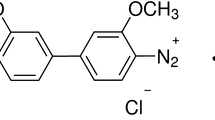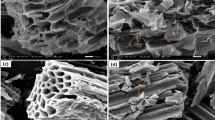Abstract
Different amine compounds, including ethylenediamine, diethylenetriamine, triethylenetetramine and tetraethylenepentamine, modified sugarcane bagasse (SCB) were prepared to improve its adsorption capacity for anionic dye Congo red. Batch studies were carried out to investigate the effect of various parameters including surface nitrogen content, the amine compounds chain length, contact time, initial concentration, solution pH and salt on the adsorption of Congo red. Results showed that the adsorption capacity of the sorbents did not increase consistently with the increase in the surface nitrogen content, and it varies in the order: unmodified < ethylenediamine-modified < diethylenetriamine-modified ≈ triethylenetetramine-modified ≈ tetraethylenepentamine-modified sugarcane bagasse. The diethylenetriamine-modified sorbent had similar capacity with the triethylenetetramine- and tetraethylenepentamine-modified sorbent. The adsorption mechanism based on electrostatic attraction and steric hindrance was proposed. pH and salt experiment illustrated that the prepared sorbents could be used in a wide pH range (5.0–12.0) and a high-salinity environment (1.0 mol L−1). Dynamic adsorption of Congo red on tetraethylenepentamine-modified SCB fixed-bed column showed that breakthrough time and saturated time were 364 and 1109 min, respectively. The modified SCB could be regenerated efficiently and used repeatedly. It had great potential in the real wastewater treatment.









Similar content being viewed by others
References
Babu BR, Parande AK, Raghu S, Kumar TP (2007) Cotton textile processing: waste generation and effluent treatment. J Cotton Sci 11:141–153
Bhattacharyya KG, Sharma A (2004) Azadirachta indica leaf powder as an effective biosorbent for dyes: a case study with aqueous Congo Red solutions. J Environ Manage 71:217–229
Bhaumik M, McCrindle R, Maity A (2013) Efficient removal of Congo red from aqueous solutions by adsorption onto interconnected polypyrrole–polyaniline nanofibres. Chem Eng J 228:506–515
Chan SL, Tan YP, Abdullah AH, Ong ST (2016) Equilibrium, kinetic and thermodynamic studies of a new potential biosorbent for the removal of Basic Blue 3 and Congo Red dyes: pineapple (Ananascomosus) plant stem. J Taiwan Inst Chem E 61:306–315
Chatterjee S, Lee MW, Wooa SH (2009) Congo red adsorption from aqueous solutions by using chitosan hydrogel beads impregnated with nonionic or anionic surfactant. Bioresour Technol 100:3862–3868
Cheng RM, Ou SJ, Li MJ, Li YJ, Xiang B (2009) Ethylenediamine modified starch as biosorbent for acid dyes. J Hazard Mater 172:1665–1670
Chiou MS, Ho P, Ho Y, Li HY (2004) Adsorption of anionic dyes in acid solutions using chemically cross-linked chitosan beads. Dyes Pigm 60:69–84
Dabrowski A (2001) Adsorption—from theory to practice. Adv Colloid Interface Sci 93:135–224
Das SK, Bhowal J, Das AR, Guha AK (2006) Adsorption behavior of rhodamine B on Rhizopus oryzae biomass. Langmuir 22:7265–7272
Gao JF, Zhang Q, Wang JH, Wu XL, Wang SY, Peng YZ (2011) Contributions of functional groups and extracellular polymeric substances on the biosorption of dyes by aerobic granules. Bioresour Technol 102:805–813
Jin LQ, Sun QC, Xu QH, Xu YJ (2015) Adsorptive removal of anionic dyes from aqueous solutions using microgel based on nanocellulose and polyvinylamine. Bioresour Technol 197:348–355
Kousha M, Daneshvar E, Sohrabi MS, Jokar M, Bhatnagar A (2012) Adsorption of acid orange II dye by raw and chemically modified brown macroalga Stoechospermum marginatum. Chem Eng J 192:67–76
Mall ID, Srivastava VC, Agarwal NK (2006) Removal of Orange-G and Methyl Violet dyes by adsorption onto bagasse fly ash-kinetic study and equilibrium isotherm analyses. Dyes Pigm 69:210–223
Mall ID, Srivastava VC, Agarwal NK (2007) Adsorptive removal of auramine-O: kinetic and equilibrium study. J Hazard Mater 143:386–395
Mane VS, Mall ID, Srivastava VC (2007) Use of bagasse fly ash as an adsorbent for the removal of brilliant green dye from aqueous solution. Dyes Pigm 73:269–278
Mao J, Won SW, Vijayaraghavan K, Yun YS (2009) Surface modification of Corynebacterium glutamicum for enhanced Reactive Red 4 biosorption. Bioresour Technol 100:1463–1466
Maurya NS, Mittal AK, Cornel P, Rother E (2006) Biosorption of dyes using dead macro fungi: effect of dye structure, ionic strength and pH. Bioresour Technol 97:512–521
Ngah WSW, Hanafiah MAKM (2008) Removal of heavy metal ions from wastewater by chemically modified plant wastes as adsorbents: a review. Bioresour Technol 99:3935–3948
Oladoja NA, Akinlabi AK (2009) Congo Red biosorption on palm kernel seed coat. Ind Eng Chem Res 48:6188–6196
Ong ST, Lee CK, Zainal Z (2007) Removal of basic and reactive dyes using ethylenediamine modified rice hull. Bioresour Technol 98:2792–2799
Pathania D, Sharma A, Siddiqi ZM (2016) Removal of Congo red dye from aqueous system using Phoenix dactylifera seeds. J Mol Liq 219:359–367
Sayğılıa H, Güzel F (2015) Performance of new mesoporous carbon sorbent prepared from grape industrial processing wastes for malachite green and Congo red removal. Chem Eng Res Des 100:27–38
Sonar SK, Niphadkar PS, Mayadevi S, Joshi PN (2014) Preparation and characterization of porous fly ash/NiFe2O4 composite: promising adsorbent for the removal of Congo red dye from aqueous Solution. Mater Chem Phys 148:371–379
Xi Y, Shen YF, Yang F, Yang GJ, Liu C, Zhang Z, Zhu DH (2013) Removal of azo dye from aqueous solution by a new biosorbent prepared with Aspergillusnidulans cultured in tobacco wastewater. J Taiwan Inst Chem E 44:815–820
Xia CL, Jing Y, Jia YZ, Yue DY, Ma J, Yin XJ (2011) Adsorption properties of Congo red from aqueous solution on modified hectorite: kinetic and thermodynamic studies. Desalination 265:81–87
Yang YY, Wang G, Wang B, Li ZL, Jia XM, Zhou QF, Zhao YH (2011) Biosorption of Acid Black 172 and Congo Red from aqueous solution by nonviable Penicillium YW 01: kinetic study, equilibrium isotherm and artificial neural network modeling. Bioresour Technol 102:828–834
Yu JX, Chi RA, Su XZ, He ZY, Qi YF (2011) Regeneration of rhodamine B loaded modified biosorbent by a self-cleaning eluent: TiO2 hydrosol. Clean-Soil Air Wate 39:400–405
Yu JX, Zhu J, Feng LY, Chi RA (2015a) Simultaneous removal of cationic and anionic dyes by the mixed sorbent of magnetic and non-magnetic modified sugarcane bagasse. J Colloid Interf Sci 451:153–160
Yu JX, Cai XL, Feng LY, Xiong WL, Zhu J, Xu YL, Zhang YF, Chi RA (2015b) Synergistic and competitive adsorption of cationic and anionic dyes on polymer modified yeast prepared at room temperature. J Taiwan Inst Chem E 57:98–103
Zhang ZY, Moghaddam L, O’Hara IM, Doherty WOS (2011) Congo Red adsorption by ball-milled sugarcane bagasse. Chem Eng J 178:122–128
Acknowledgments
The work is financially supported by National Natural Science Foundation of China (No. 51574182), the Key Project of Chinese Ministry of Education (No. 213024A) and the program for excellent young scientific and technological innovation team of Hubei Provincial Department of Education, China (No. T201506).
Author information
Authors and Affiliations
Corresponding author
Rights and permissions
About this article
Cite this article
Yu, Jx., Xiong, Wl., Zhu, J. et al. Removal of Congo red from aqueous solution by adsorption onto different amine compounds modified sugarcane bagasse. Clean Techn Environ Policy 19, 517–525 (2017). https://doi.org/10.1007/s10098-016-1243-7
Received:
Accepted:
Published:
Issue Date:
DOI: https://doi.org/10.1007/s10098-016-1243-7




